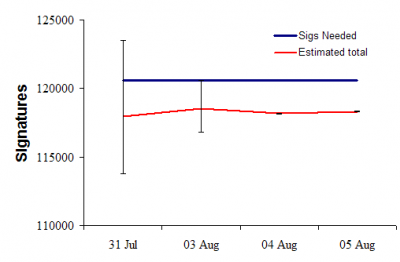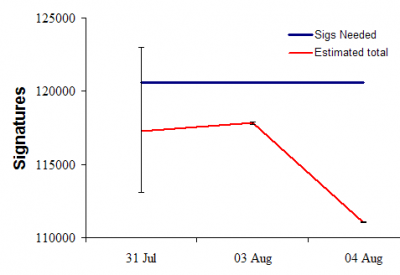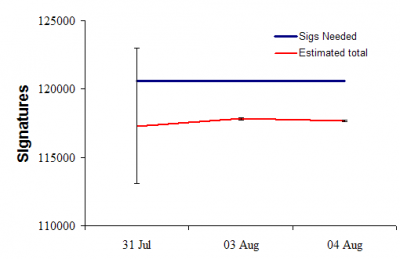The full numbers from Wednesday’s counts were released this morning by the Secretary of State’s (SoS) office. They’ve driven another nail in the coffin of R-71.
A total of 23,457 signatures have been checks, which is 17% of the total. Overall 3,054 invalid signatures have been found and eliminated, including 68 duplicates, 2,764 individuals not on the voting rolls, 221 signature mismatches, and 69 signatures for which the corresponding signature is missing.
The cumulative error rate is 13.3%, if the signatures with missing signature cards (hereafter “missing”) are thrown out, or 13.0% if the missing signatures are fully counted. As Goldy has explained, the cumulative error rate for the sample is misleadingly low. This is because duplicates are exponentially underrepresented as the sample size goes down.
Given the number of duplicates found in this sample, the best estimate is that is about 1.7% of signatures are duplicates on the petition. That gives an estimated total rejection rate of 14.7% (treating all “missing” signatures as valid). A rejection rate over 12.4% keeps R-71 off the ballot.
Rather than focus on percentages, we can use the number of good and bad signatures to estimate the expected number of valid signatures. This figure shows the daily estimated number of valid signatures on the petition (red line) and the number of signatures required (blue line) for the measure to make the ballot:
These estimates are conservative because I am assuming all “missing” signatures will be treated as valid. (I’ve changed my methods a bit since yesterday—a journey through the methodological details begins below the fold).
The important things to notice here are:
- The estimates are stable rather than bouncing around from day to day. This means that there is little evidence for non-sampling error. Such errors can arise if batches of petitions showed widely different error rates (more generally, from non-independence among signatures on petitions and in batches of petitions).
- The 95% confidence intervals are now so small that sampling error is no longer relevant. If God plays dice, she clearly doesn’t want R-71 on the ballot.
The trends, so far, indicate that, short of a miracle, this measure will not qualify for the ballot.
At this point, I am going to totally geek-out and discuss methodological stuff. If you’re interested, venture below the fold.



